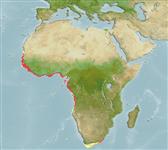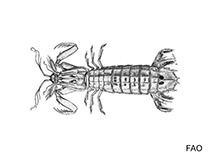Squilla cadenati Manning, 1970
Angolan mantis shrimp| Native range | All suitable habitat | Point map | Year 2050 |

|
| This map was computer-generated and has not yet been reviewed. |
| Squilla cadenati AquaMaps Data sources: GBIF OBIS |
Upload your photos
Google image | No image available for this species;
drawing shows typical species in Squillidae.
Google image | No image available for this species;
drawing shows typical species in Squillidae.
Classification / Names Common names | Synonyms | CoL | ITIS | WoRMS
Malacostraca | Stomatopoda | Squillidae
Environment: milieu / climate zone / depth range / distribution range Ecology
Benthic; depth range 37 - 300 m (Ref. 436). Tropical
Distribution Countries | FAO areas | Ecosystems | Occurrences | Introductions
Eastern Atlantic: Off West Africa, from Senegal to Angola.
Length at first maturity / Size / Weight / Age
Maturity: Lm ? range ? - ? cm Max length : 17.0 cm BL male/unsexed; (Ref. 417); common length : 15.0 cm BL male/unsexed; (Ref. 436)
Short description Morphology
A moderately sized stomatopod. Body with conspicuous longitudinal ridges: sub median ridges of fifth abdominal segment with posterior spines; tail segment with a distinct median ridge. Claws large, armed with 6 spines on the terminal segment. Color: telson with a pair of dark triangle anteriorly, bright red in life (Ref. 436).
Life cycle and mating behavior Maturity | Reproduction | Spawning | Eggs | Fecundity | Larvae
Some members of the order Stomatopoda pair for life and some come together only to mate. Males produce sperm ducts rather than spermatophores; females can brood a maximum of 50,000 eggs. Life cycle: Eggs hatch to a planktonic zoea which lasts for 3 months.
Main reference
References | Coordinator | Collaborators
Schneider, W. 1990. (Ref. 417)
IUCN Red List Status (Ref. 130435: Version 2024-1)
CITES status (Ref. 108899)
Not Evaluated
CMS (Ref. 116361)
Not Evaluated
Threat to humans
Harmless
Human uses
| FishSource |
Tools
More information
Trophic Ecology
Food items
Diet
Food consumption
Ration
Predators
Diet
Food consumption
Ration
Predators
Ecology
Population dynamics
Life cycle
Distribution
Human Related
Aquaculture profile
Stamps, Coins Misc.
Stamps, Coins Misc.
Outreach
References
Internet sources
BHL | BOLD Systems | CISTI | DiscoverLife | FAO(Publication : search) | Fishipedia | GenBank (genome, nucleotide) | GloBI | Gomexsi | Google Books | Google Scholar | Google | PubMed | Tree of Life | Wikipedia (Go, Search) | Zoological Record
Estimates based on models
Preferred temperature
(Ref. 115969): 14.2 - 17.8, mean 16.3 (based on 35 cells).
Price category
(Ref. 80766):
Unknown.



